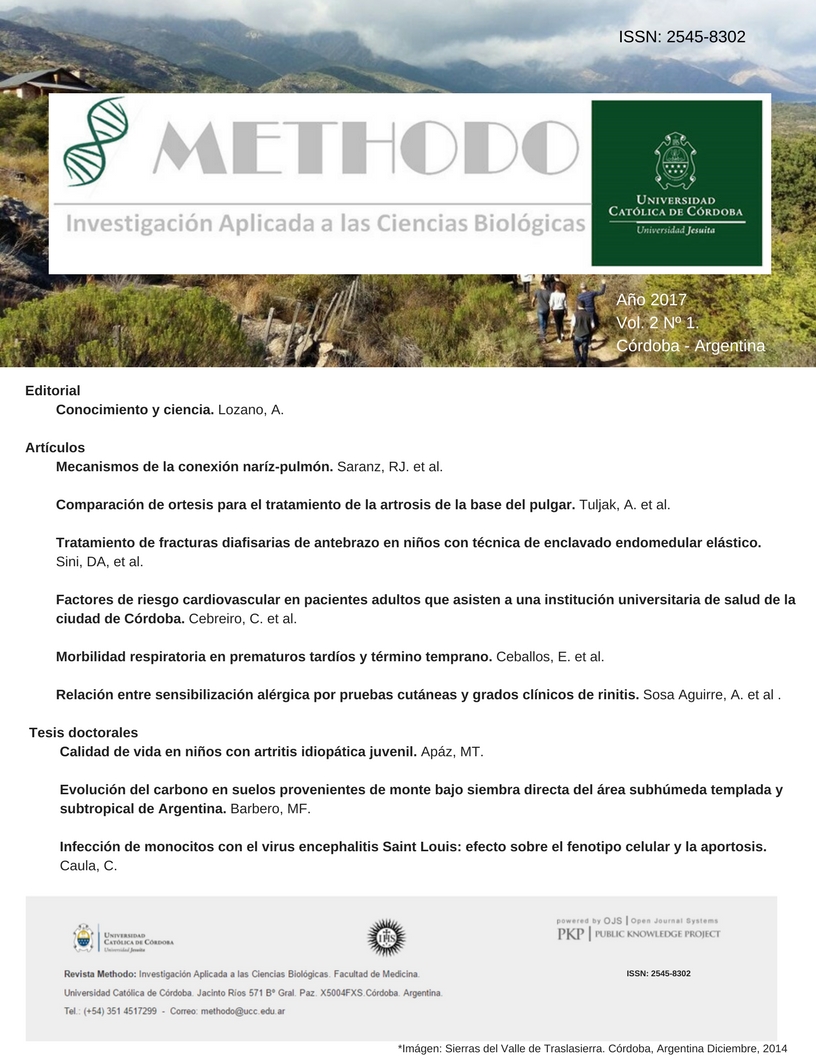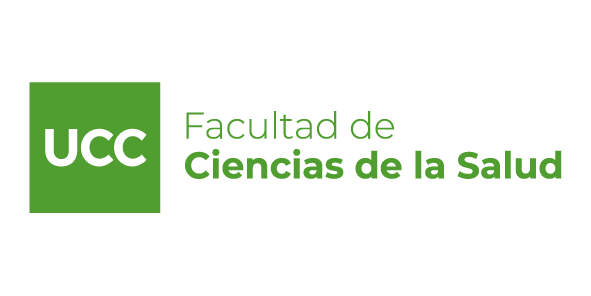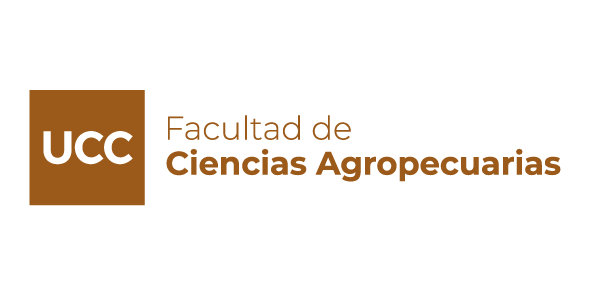Evolución del carbono en suelos provenientes de monte bajo siembra directa del área subhúmeda templada y subtropical de Argentina
Palabras clave:
carbono orgánico, siembra directa, monte, estabilidad estructural, pastura, sojaResumen
Se desconocen los efectos de la Siembra directa (SD) sobre la calidad del suelo en zonas de expansión agropecuaria como ocurre en la región subhúmeda subtropical y templada de Argentina. Se traslada una práctica que hasta el momento funciona en determinadas zonas a otras, donde no se hizo anteriormente agricultura ni se conoce el comportamiento del recurso suelo. El clima influye sobre el Carbono orgánico (CO) y por consiguiente sobre el comportamiento general del suelo. El objetivo de este trabajo fue evaluar la evolución del CO en suelos provenientes de monte natural (prístino, en recuperación y degradado) y su relación con las variables densidad aparente, estabilidad estructural humedad, pH, arcilla, nitrógeno total y fósforo extraíble para determinar si la SD puede ser una práctica sostenible en el tiempo. Las pérdidas ocurrieron en las dos profundidades estudiadas (0 - 0,20 y 0,20 - 0,50 m). Se perdieron anualmente tomando como referencia monte prístino (90,67 Mg ha-1) entre 6,63 y 18,71 Mg ha-1 de CO en la profundidad de 0 - 0,50 m. En la zona templada subhúmeda las pérdidas de CO en suelos que poseen como situación inicial monte degradado (86,92 Mg ha-1) fueron de 0,901 y 0,916 Mg ha-1 de CO en la profundidad de 0 - 0,50 m. Los suelos que poseen como situación inicial pastura comparados con monte en recuperación (CO 66,15 Mg ha-1) presentaron ganancias de CO en la profundidad de 0 - 0,50 m. La interacción entre variables condiciona el comportamiento del suelo. La estabilidad estructural interviene como variable para predecir el comportamiento del CO de suelo en las dos zonas climáticas estudiadas. El beneficio “demostrado” de la SD sobre el secuestro de C esta supeditado a las condiciones agroecológicas y de manejo como así también a las interacciones entre las propiedades físicas y químicas de cada sueloDescargas
Referencias
Albiach R., Canet R., Pomares F. e Ingelmo F.2001. Organic matter components, agrégate stability and biological activity in a horticultural soil fertilized with differents rates of two sewage sludges during ten years. Bioresource Technology 44:109-114. https://doi.org/10.1016/S0960-8524(00)00166-8
Alvarez C.R., Taboada M.A., Bono A., Fernandez P.L. y Prystupa P. 2009. Topsoil properties as affected by tillage Systems in the Rolling Pampa region of Argentina. Soil Sci. Soc. Am. J 73:1242-1250. https://doi.org/10.2136/sssaj2008.0246
Alvarez, R., M.E. Russo, P. Prystupa, J.D. Scheiner, and L. Blotta. 1998. Soil carbon pools under conventional and no -tillage systems in the Argentine Rolling Pampa. Agronomy Journal 90:138-143. https://doi.org/10.2134/agronj1998.00021962009000020003x
Alvarez R., Steinbach H.S. 2006. materia orgánica, valor agronómico y dinámica en suelos pampeanos. Ed. Facultad de Agronomía. Universidad de Buenos Aires. pp:206
Alzugaray C., Vilche M. S. y Petenello C. 2008. Labor profunda en siembra directa: Efecto sobre la condición biológica del suelo. Cien. Inv. Agr. 35(3): 265-276 https://doi.org/10.4067/S0718-16202008000300004
Angers D.A., N'dayegamiye A. y Coté D.1993. Tillage-induced differences in organic matter of particle size fractions and microbial biomass. Soil Sci. Soc. Am. J 57: 512-516. https://doi.org/10.2136/sssaj1993.03615995005700020035x
Angueira C., Prieto D., López J., Barraza G. 2006. Sistema de Información Geográfica de Santiago del Estero. Ed. Instituto Nacional de Tecnología Agropecuaria. CD.
Apezteguía H.P. 2005. Tesis Doctoral. Dinámica de la materia orgánica de los suelos de la Región Semiárida Central de Córdoba (Argentina). Universidad Nacional de Córdoba. Córdoba. Argentina. 145pp
Apezteguía H.P., Izaurralde R.C. y Sereno R. 2009. Simulation study of soil organic matter dynamics as affected by land use and agricultural practices in semiarid Córdoba, Argentina. Soil & Tillage Research 102: 101-108 https://doi.org/10.1016/j.still.2008.07.016
Barral M.T., Buján E., Devesa R., Iglesias M.L. y Velazco Molina M. 2007. Comparison of the structural stability of pasture and cultivated soils. Science of the Total Environmente 378:174-178. https://doi.org/10.1016/j.scitotenv.2007.01.045
Beare M.H., Hendrix P.F. y Coleman D.C. 1994. Water-stable aggregates and organic matter fractions in conventional and no-tillage soils. Soil Sci. Soc. Am. J. 58:777-786 https://doi.org/10.2136/sssaj1994.03615995005800030020x
Benjamin J.G., Mikha M.M y Vigil M.F. 2008. Organic carbon effects on soil physical and hydraulic properties in a semiarid climate. Soil Sci. Soc. Am. J. 72:1357-1362 https://doi.org/10.2136/sssaj2007.0389
BirdLife IBA Factsheet. Parque Nacional Copo. Disponible en http://www.birdlife.org, marzo 2010.
Blanco - Canqui H., Mikha M.M., Benjamín J.G., Stone L.R., Schlegel A.J., Lyon D.J., Vigil M.F. y Stahlman P.W. 2009. Regional study of no till impacts on near-surface aggregate properties that unfluence soil erodibility. 2009. Soil Sci. Soc. Am. J. 73:1361-1368 https://doi.org/10.2136/sssaj2008.0401
Blanco-Canqui, H., and R. Lal. 2008. No-tillage and soil profile tillage sequestration: An on farm assessment. Soil Sci. Soc. Am. J. 72: 693-701 https://doi.org/10.2136/sssaj2007.0233
Bonel B.A., Morrás H.J.M. y Bisaro V., 2005. Modificaciones de la microestructura y la materia orgánica en un Argiudol bajo distintas condiciones de cultivo y conservación. Ciencia del Suelo (Argentina) 23 (1):1-12
Bono A., Alvarez R., Buschiazzo D.E. y Cantet R.J.C. 2008.Tillage effects on soil carbon balance in a semiarid agroecosystem. Soil Sci. Soc. Am. J 72: 1140-1149 https://doi.org/10.2136/sssaj2007.0250
Broder M.W. y Wagner G.H. 1988. Microbial Colinization and decomposition of Corn, Wheat and Soybean residue. Soil Sci. Soc. Am. J. 52:112-117 https://doi.org/10.2136/sssaj1988.03615995005200010020x
Burke W, Gabriels D. y Bouma J. 1986. Soil structure assesment. AA. Balkema. Rotterdam Cabido D., Cabido M., Garré S.M., Gorgas J.A., Miatello R., Ravelo A., Rambaldi S., Tassile J.L. 2003. AGENCIA CÓRDOBA D.A.C.y T. - Dirección de Ambiente. Córdoba - Argentina. 101pp
Cacchiarelli J., Galantini J.A. y Rosell R.A. 2008. Estabilidad estructural y P en fracciones de agregados en la cuenca del A° El Divisorio (Coronel Pringles, BA) Ci. Suelo (Argentina) 26(1):71-79.
Cambardella C.A. y Elliot E.T. 1992. Particulate soil organic-matter changes across a grassland cultivation sequence. Soil Sci. Soc. Am. J 56: 777-783. https://doi.org/10.2136/sssaj1992.03615995005600030017x
Cambardella C.A. y Elliot E.T. 1993. Carbon and Nitrogen in agregates fron cultivate and native grassland soils. Soil Sci. Soc. Am. J 57: 1071-1076 https://doi.org/10.2136/sssaj1993.03615995005700040032x
Cole C.V., Duxbury J., Freney J., Heinemeyer O., Minami K., Mosier A., Paustian K., Rosenberg N., Sampson N., Sauerbeck D. y Zhao Q. 1997. Global estimates of potential mitigation of greenhouse gas emissions by agriculture. Nutrient cycking in Agroecosystems 49: 221-228 https://doi.org/10.1023/A:1009731711346
de la Rosa D, 2008. Evaluación agro-ecológica de suelos. Ediciones Mundi - Prensa. Madrid. España. 404 pp
De-Campos A., Mamedov A.I. y Huang Chi-hua. 2009. Short-term reducing conditions decrease soil aggregation. 2009. Soil Sci. Soc. Am. J. 73:550-559 Derpsch, R. 2008. Área bajo siembra directa en varios países. Disponible en
https://doi.org/10.2136/sssaj2007.0425
Díaz Zorita M., Duarte G.A. y Grove J.H. 2002. A review of no till systems and soil management for sustainable crop production in the subhumid and semiarid Pampas of Argentina. Soil & Tillage Research 65:1-18 105 https://doi.org/10.1016/S0167-1987(01)00274-4
Díaz Zorita M., Duarte G.A. y Grove J.H. 2002. A review of no-till Systems and soil management for sustainable crop production in the subhumid and semiarid Pampas of Argentina. Soil & Tillage Research 65:1-18 https://doi.org/10.1016/S0167-1987(01)00274-4
Díaz Zorita M., Grove J.H., Murdock L., Herbeck J. Y Perfect E. 2004. Soil Structural disturbance effects on crop yields and soil properties in a no till production system. Agron. J. 96: 1651-1659. https://doi.org/10.2134/agronj2004.1651
Dinel, H., Lévesque P.E.M., Jambu P. y Righi D.1992. Microbial activity and long-chain aliphaticas in the formation of stable soil aggregates. Soil Sci. Soc. Am. J.56:1455- 1463 https://doi.org/10.2136/sssaj1992.03615995005600050020x
Doran J.W. 1980. Soil microbial and biochemical changes associated with reduced tillage. Soil Sci. Soc. Am. J 44: 765-771 https://doi.org/10.2136/sssaj1980.03615995004400040022x
Fabrizzi K.R., Morón A. y García F.O. 2003. Soil Carbon and Nitrogen fractions in degraded vs. non-degraded Mollisols in Argentina. Soil Sci. Soc. Am. J 67: 1831-1841 https://doi.org/10.2136/sssaj2003.1831
Ferreras L., Magra G., Besson P., Kovalevski E. y Garcia F. 2007.Indicadores de calidad Física en suelos de la Región Pampeana Norte de Argentina bajo siembra directa. Ciencia del suelo (Argentina) 25 (2): 159-172
Ferreras L., Magra G., Besson P., Kovalevski E. y García F. 2007. Indicadores de calidad física en suelos de la región pampeana norte de Argentina bajo siembra directa. Ci. Suelo (Argentina) 25(2):159-172.
Franzluebbers A.J., Stuedemann J.A.2008. Early response of soil organic fractions to tillage and integrated crop-livestock production. Soil Sci. Soc. Am. J 72:613-625 https://doi.org/10.2136/sssaj2007.0121
Franzluebbers A.J. 2010. Achieving soil organic carbon sequestration with conservation agricultural Systems in the Southeastern United States. Soil Sci. Soc. Am. J. 74:347- 357. https://doi.org/10.2136/sssaj2009.0079
Frioni, L. 1990 Ecología microbiana del suelo, Departamento de Publicaciones de la Universidad de la República. Montevideo. Uruguay. 519pp
Fuentes A. J, Cantero Martínez C., López M.V., Paustian K., Denef K., Stewart C.E., y Arrúe J.L. 2009. Soil Aggregation and soil organic carbon stabilization: effects of management in semiarid mediterranean agroecosystems. Soil Sci. Soc. Am. J. 73:1519-1529 https://doi.org/10.2136/sssaj2008.0333
Gale W.J. y Cambardella C.A. 2000. Carbon dynamicas of surface residue- and root derived organic matter under simulated no-till. 2000. Soil Sci. Soc. Am. J 64: 190-19h https://doi.org/10.2136/sssaj2000.641190x
Golchin J, Oades M., Skemstad J.O y Clarke P.1994. Soil structure and Carbon cycling. Aust. J. Soil Res. 32:1043-1068 https://doi.org/10.1071/SR9941043
Gorgas, J.A, Tassile J.L., 2003. Los Suelos. Agencia Córdoba D.A.C. y T.S.E.M.. INTA Manfredi. Córdoba. Argentina. 567 pp.
Grandy A.S. y Robertson G.P. 2006. Agregation and organic matter protection following tillage of a previously uncultivated soil. Soil Sci. Soc. Am. J 70: 1398-1406 106 https://doi.org/10.2136/sssaj2005.0313
Hartemink, A. E. 2002. Soil science in tropical and temperate regions. Adv. Agron.77: 269 - 291. https://doi.org/10.1016/S0065-2113(02)77016-8
Henin S., Grass R. y Monnier G. 1972. El Perfil Cultural. Ediciones Mundi - Prensa. Madrid. España. 342 pp
Huggins D.R., Allmaras R.R., Clapp C.E., Lamb J.A. y Randall G.W. 2007. Soil Sci. Soc. Am. J. 71:145-154 InfoStat (2009). InfoStat versión 2009p. https://doi.org/10.2136/sssaj2005.0231
Grupo InfoStat, FCA, Universidad Nacional de Córdoba. Argentina Izaurralde R.C., McGill W.B., Robertson J.A., Juma N.G. y Thurston J.J. 2001. Soil Sci. Soc. Am. J 65: 431-441 https://doi.org/10.2136/sssaj2001.652431x
Jackson M. 1964. Análisis químico de los suelos. Editorial Omega S.A. Barcelona. España. 662 pp.
Janzen H.H., Campbell C.A., Brandt S.A., Lafond G.P. y Townley- Smith L. Light-fraction organic matter in soils from long term crop rotations. 1992. Soil Sci. Soc. Am. J 56: 1799-1806. https://doi.org/10.2136/sssaj1992.03615995005600060025x
Jelinski N.A. y Kcharik C.J. 2009. Land-use effects on soil carbon and nitrogen on a U.S. Midwestern Floodplain. 2009. Soil Sci. Soc. Am. J 73: 217-225 https://doi.org/10.2136/sssaj2007.0424
Johnson J.M.F., Barbour N.W. y Weyers S.L. 2007. Chemical composition of crop biomass impacts its decomposition. Soil Sci. Soc. Am. J 71: 155-162 https://doi.org/10.2136/sssaj2005.0419
Lal R. 2004. Soil carbon sequestration to mitigate climate change. Geoderma 123:1-22. https://doi.org/10.1016/j.geoderma.2004.01.032
Lal R., Mahboubi A.A. y Fausey N.R. 1994. Long-term tillage and rotation effects on properties of a central Ohio soil. Soil Sci. Soc. Am. J 58: 517-522 https://doi.org/10.2136/sssaj1994.03615995005800020038x
Lal, R, D.C. Reicosky, and J.D. Hanson. 2007. Evolution of the plow over 10.000 years and the rationale for no-till farming. Soil Tillage Res. 93:1-12. https://doi.org/10.1016/j.still.2006.11.004
Lal, R. 2010. Enhancing Eco-efficiency in Agro-ecosystems through Soil Carbon Sequestration. Crop Science, Vol 50, March - April 2010. https://doi.org/10.2135/cropsci2010.01.0012
McCallister D.L., Bahadir M.A. y Blumenthal J.M. 2002. Phosphorus partitioning and phosphatase activity in semi-arid region soils under increasing crop growth intensity. Soil Science 16709:616-624. https://doi.org/10.1097/00010694-200209000-00006
Melo O.E., Boetto G.C. y Gómez Demmel A.M. 1993. MBG Carne (Versión 06) Software de cómputo. Córdoba. Argentina
Mengel K., Kirkby E.A. 2000. Instituto Internacional del Potasio. Basilea. Suiza 608 pp
Mickovski S.B., Hallet P.D., Bransby M.F., Davies M.C.R., Sonnenberg R. Y Bengough A G. 2009. Mechanical reiforcement of soil by willow roots: impacts of root properties and root failure mechanism. 2009. Soil Sci. Soc. Am. J. 73:1276-1285. https://doi.org/10.2136/sssaj2008.0172
Micucci, F.G., and M. A. Taboada. 2006. Soil physical properties and soybean (Glycine max Merrill) root abundance in conventionally - and zero - tilled soils in the humid Pampas of Argentina. Soil Tillage Res. 86: 152-162 https://doi.org/10.1016/j.still.2005.02.004
Mirsky S.B., Lanyon L.E. y Needelman B.A. 2008. Evaluating soil management using particulate and chemically labile soil organic matter fractions. Soil Sci. Soc. Am. J 72: 180-185. https://doi.org/10.2136/sssaj2005.0279
Mondino M., Peterlín O., Puig O., Cataldo F., Gómez N., Baigorrí H. 2003. Producción de soja en Santiago del Estero. INTA, disponible en http://www.inta.gov.ar/santiago/info/documentos/soja/0001art_sojaproduccion.htm, marzo 2010
Murage E.W., Voroney P. R., Kay B.D., Deen B. Y Beyaert R.P. 2007. Dynamicas and turnover of soil organic matter as affected by tillage. Soil Sci. Soc. Am. J 71: 1363- 1370. https://doi.org/10.2136/sssaj2006.0196
Navarro G. 2003. Química Agrícola. Ediciones Mundi - Prensa. Madrid. España. 487 pp.
Olchin G.P., Frey S.D., Filley T.R., Paustian K. y Six J. 2008. Residue carbon stabilization in soil aggregates of no-till and tillage management of dryland cropping systems. Soil Sci. Soc. Am. J. 42:507-513 https://doi.org/10.2136/sssaj2006.0417
Olchin G.P., Ogle S., Frey S.D., Filley T.R., Paustian K. Y Six J. 2008. Residue carbon stabilization in soil aggregates of no-till and tillage managemente of dryland cropping systems. Soil Sci. Soc. Am. J 72: 507-513 https://doi.org/10.2136/sssaj2006.0417
Orellana J.A. De, Pilatti, M.A. 1994. La estabilidad de agregados como indicador edáfico de sostenibilidad, Ciencia del suelo (2): 75-80
Piccolo A. y Mbagwu J.S.C 1999. Role of hydrofobic components of soil organic matter in soil agrégate stability. Soil Sci. Soc. Am. J. 63:1801-1810 https://doi.org/10.2136/sssaj1999.6361801x
Piccolo A. y Mbagwu J.S.C. 1994. Humic substance and surfactants effects on the stability of two tropical soils. Soil Sci. Soc. Am. J.58:950-955 https://doi.org/10.2136/sssaj1994.03615995005800030044x
Pikul J.L., Chilom G., Rice J., Eynard A., Schumacher T. E., Nichols K., Johnson J.M.F., Wright S., Caesar T. y Ellsbury M. 2009. Organic matter and water stability of field aggregates affected by tillage in South Dakota. Soil Sci. Soc. Am. J. 73:197-206 https://doi.org/10.2136/sssaj2007.0184
Pilatti M.A., Orellana J.A. de, Priano L.J., Felli O.M. y Grenon D.A. 1988. Ciencia del Suelo Vol. 6 N°1:19-29. Plante, A.F., Six J., Paul E.A., Conant R.T., 2009. Does physical protection of soil organic matter arrenuate temperature sensitivity? Soil Sci. Soc. Am. J 73: 1168-1172. https://doi.org/10.2136/sssaj2008.0351
Pullido Moncada M.A., Lobo Luján D. y Lozano Pérez Z. 2009. Asociación entre indicadores de estabilidad estructural y la materia orgánica en suelos agrícolas de Venezuela. Agrociencia 43:221-230.
Quiroga A., Ormeño O., Peinemann, N. 2001. Materia orgánica. Un indicador de calidad de suelos relacionado con la productividad de los cultivos. INTA Anguil, Bol. Div. Técnica 70:28pp
Ran y., Sun K., Xing B., Shen C. 2009. Characterization of condensed organic matter in soils and sediments. Soil Sci. Soc. Am. J 73: 351-359
Rhoton, F.E. 2000. Influence of time on soil response to no-till practices. Soil Sci. Soc. Am. J. 64:700-709
Roberts T.L., Henry J.L., Potash & Phosphate Institute (PPI), Informaciones agronómicas N° 42, disponible http://www.ppi.org, marzo 2010. Sá J.C. M de, Cerri C.C., Dick W.A., Lal R., Filho S.P.V., Piccolo M.C. y Feigl B. E. 2001. Organic matter dynamicas and carbon sequestration rates for a tillage chronosecuence in a Brazilian Oxisol. Soil Sci. Soc. Am. J 65: 1486 - 1499
Sá Moraes de J.C., Cerri C.C., Piccolo M. C., Feigl B. E., Seguy L., Bouzinac S., Venzke S.P. y Neto M.S. 2003. Acumulación de materia orgánica en suelos bajo siembra directa, con el pasar de los años. Publicado en Internet, disponible en http://www.aapresid.org.ar/apadmin/img/upload/suelo%20-%20003.pdf, marzo 2010
SAMLA 2004. Sistema de apoyo a los Laboratorios dedicados al Análisis de Suelos, Aguas, Vegetales y Enmiendas Orgánicas. Recopilación de las tecnicas de laboratorio vigentes y reconocidas por el SAMLA, en proceso de revisión y actualización en el marco del convenio IRAM-SAGPyA. Año de edición 2004. Resolución Nº 478/98 y 238/03. www.sagpya.gov.ar, marzo 2005.
Sanzano G.A., Corbella R.D., García J.R. y Fadda G.S. 2005. Degradación física y química de un haplustol Típico bajo distintos sistemas de manejo de suelo. Ci. Suelo (Argentina) 23 (1):93-100
SAS® v.9.1. (2005). SAS/STAT® User's guide. SAS Institute Inc., Cary, NC.
Sasal, M.C., A. E, Andriulo, and M. A. Taboada. 2006. Soil porosity characteristics and water movement under zero tillage in silty soils in Argentinean Pampas. Soil Tillage Res. 87:9-18. https://doi.org/10.1016/j.still.2005.02.025
Satorre E. H. 2005. Cambios tecnológicos en la agricultura Argentina actual. Revista Ciencia Hoy 15 n° 87: 24-31
Schutter M.E., Dick R.P. 2002. Microbial community profiles and activities among aggregates of winter fallow and cover-cropped soil. Soil Sci. Soc. Am. J. 66:142-153 https://doi.org/10.2136/sssaj2002.1420
Sherrod L.A., Peterson G.A., Westfall D.G. y Ahuja L.R. 2005. Soil organic carbon pools after12 years in no-till dryland agroecosystems. Soil Sci. Soc. Am. J 69:1600-1608. https://doi.org/10.2136/sssaj2003.0266
Singh S., Mishra R., Singh A., Ghoshal N. y Singh K.P.2009. Soil physicochemical properties in a grassland and agrecosystem receiving varying organic inputs. Soil Sci. Soc. Am. J. 73:1530-1538 https://doi.org/10.2136/sssaj2008.0301
Six J., Elliot E.T. y Paustian K. 1999. Aggergate and soil organic matter dynamicas under conventional and no-tillage systems. Soil Sci. Soc. Am. J. 63:1350-1358 https://doi.org/10.2136/sssaj1999.6351350x
Six J., Elliot E.T., Paustian K y Doran J.W. 1998. Aggregation and soil organic matter accumulation in cultivated and native grassland soils. Soil Sci. Soc. Am. J. 60:1367- 1377. https://doi.org/10.2136/sssaj1998.03615995006200050032x
Smith P., Martino D., Cai Z., Gwary D., Janzen H., Kumar P., McCarl B., Ogle S., Mara F.O., Rice C., Scholes B., Sirotenko O., Howden M., Mc Allister T., Pan G., Romanenkov V., Schneider U., Towprayoon S., Wattenbach M y Smith J. 2008. Greenhouse gas mitigation in agriculture. Phil. Trans. R. Soc. 363: 789-813 https://doi.org/10.1098/rstb.2007.2184
Steinbach, H.S, and R. Alvarez. 2006. Changes in soil organic carbon contents and nitrous oxide emissions after introduction of no-till in Pampean Agroecosystems. Journal of Environmental Quality 35:3-13. https://doi.org/10.2134/jeq2005.0050
Taboada M.A. 2007. Efectos del pisoteo y pastoreo animal sobre suelos en siembra directa. 4° Simposio de ganadería en Siembra Directa, Aapresid. Potrero de los Funes. San Luis 71-83.
Taboada, M.A., F.G. Micucci, D.J. Cosentino, and R.S. Lavado. 1998. Comparison of compaction induced by conventional and zero tillage in two soils of the Rolling Pampa of Argentina. Soil Tillage Res. 49:57-63. https://doi.org/10.1016/S0167-1987(98)00132-9
Taboada, M.A., Micucci F.G. 2002. Fertilidad física de los suelos. Editorial Facultad de Agronomía. Universidad de Buenos Aires. Argentina. 79 pp.
Torres P., Abril A. 1996. Dinámica microbiana del suelo en un desmonte selectivo del Chaco árido argentino. Ciencia del Suelo 14:30-36
Trewartha, G.T. 1968. An introduction to climate. McGraw-Hill book company. 1968
Vadas P. A.2006. Distribution of Phosphorus in manure slurry and its infiltration afeter applications to soils. J. Envirom. Qual. 35:542-547. https://doi.org/10.2134/jeq2005.0214
Van Ginkel J.H. y Gorissen A. 1998. In situ decomposition of grass roots as affected by elevated atmospheric carbon dioxide. Soil Sci. Soc. Am. J 62: 951-958 https://doi.org/10.2136/sssaj1998.03615995006200040015x
Villamil M.B., Bollero G.A., Darmody R.G., Simmons F.W y Bullock D.G. 2006. No-till Corn/Soybean systems including winter cover crops: effects on soil properties. Soil Sci. Soc. Am. J 70: 1936-1944 https://doi.org/10.2136/sssaj2005.0350
White P.M. y Rice C.W. 2009. Tillage effects on microbial and carbon dynamics during plant residue decomposition. Soil Sci. Soc. Am. J 73: 138-145. https://doi.org/10.2136/sssaj2007.0384
Wild, A. 1992. Condiciones del suelo y desarrollo de las plantas según Russell. Ed. Mundi Prensa. Madrid. España. pp: 1045.
Wu C., Wu J., Luo Y, Zhang, L. Y DeGloria S.D. 2009. Spatial prediction of soil organic matter content using cokriging with remotely sensed data. Soil Sci. Soc. Am. J 73: 1202 - 1208 https://doi.org/10.2136/sssaj2008.0045
Wu Z., Powell J.M. 2007. Dairy manure type, application rate, and frecuency impact plants and soils. Soil Sci. Soc. Am. J 71:1306-1313 https://doi.org/10.2136/sssaj2006.0419












